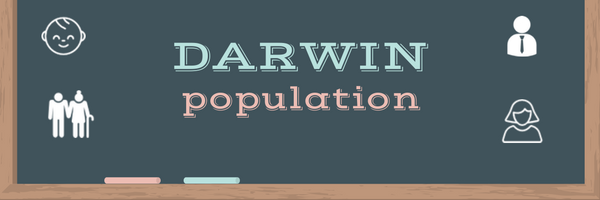
Darwin is the state capital city of Northern Territory. Darwin has an estimated population of over 150,000 people, which accounts for 0.60% of Australia population. Darwin is the least populated capital city in Australia. The size of Darwin is 3,163.9 km². Over half of Northern Territory population lives in Darwin. By 2016 Litchfield has overtaken Palmerston as the second largest municipality in metropolitan Darwin.
Based on our research, Darwin population will reach 171,264 by the end of June of 2024. We use end of June each year due to ABS always follow Australia financial year when pushed the data. The calculation is based on the average growth rate of 2.20% over last 12 years since 2011. We believe using the recent years’ figures (see the table in next section) will make the estimation more accurate.
Population Growth of Darwin
Darwin is one of the fastest growing capital cities in Australia, with an annual growth rate of 2.6 per cent since the 2006 census. Looking back last twelve years, Darwin’s population grow rate is very consistent and strong ranging from 1.35% to 3.08%, adding around 1,900 to 4,200 people each year to the overall population.
| Year | Population | Growth Rate |
| 2011 | 129,100 | n/a |
| 2012 | 132,300 | 2.48% |
| 2013 | 136,200 | 2.95% |
| 2014 | 140,400 | 3.08% |
| 2015 | 142,300 | 1.35% |
| 2016 | 145,804 | 2.46% |
| 2017 | 148,393 | 1.78% |
| 2018 | 150,880 | 1.68% |
| 2019 | 154,280 | 2.25% |
| 2020 | 157,920 | 2.36% |
| 2021 | 161,178 | 2.06% |
| 2022 | 164,230 | 1.89% |
| 2023 | 167,580 | 2.04% |
Demography of Darwin
According to census, 51.7 percent of people in Darwin are male and 48.3 percent are female. The top five ancestries for people in Darwin are: Australian, English, Australian Aboriginal, Irish and Scottish. The top five languages (other than English) spoken in Darwin are: Kriol, Djambarrpuyngu, Greek, Warlpiri and Murrinh Patha. The top six countries of birth for people in Darwin are: Australia, England, New Zealand, Philippines, India and the United States of America.
Christianity is the dominant religion in Darwin, which has 49.5 per cent of the population of the city. The largest denominations of Christianity are Roman Catholicism (21.5%), Anglicanism 12.3% and Greek Orthodoxy (2.6%). Other religions like Buddhists, Muslims, Hindus and Jews account for 3.2% of Darwin’s population. There were 23.3 per cent of people has no religion.
The main occupations of people living in Darwin are Professionals, Technicians & trades workers, Clerical & administrative workers, Community & personal service workers, Managers, Labourers, Sales workers, Machinery operators & drivers.
Population Density of Darwin
Darwin population density is 44.98 people per square kilometer, which is ranking the least populated capital city in Australia. Darwin’s population density is only 10 percent of Melbourne’s population. It is definitely one of the least populated cities by world standard.
| Position | State | Population density |
| 1 | Melbourne | 453/km2 |
| 2 | Adelaide | 404.205/km2 |
| 3 | Sydney | 400/km2 |
| 4 | Perth | 317.736/km2 |
| 5 | Canberra | 173.3/km² |
| 6 | Brisbane | 145/km2 |
| 7 | Hobart | 124.8/km2 |
| 8 | Darwin | 44.98/km2 |
Facts About Darwin
- The harbour in Darwin is twice the size of Sydney Harbour.
- About three fourths of the population lives in the Darwin and Alice Springs metropolitan areas.
- Darwin is closer to Dili, Denpasar and Jakarta in Indonesia and Port Moresby in Papua New Guinea than it is to any other Australian capital city.
- Darwin became the city’s official name in 1911.
- The National Park is named after Charles Darwin, a famous researcher who invented the idea of Darwinism.
- The Aboriginal people of the Larrakia language group are the traditional custodians and the first inhabitants of the greater Darwin area.
- Darwin was built at least four times. The first construction was after it received the air raid from Japan in the Second World War. Another construction occurred after it was hit by cyclone in 1897, a cyclone in 1937 and 1974 cyclone Trac.
- After the 1974 Cyclone Tracy, 70 per cent of Darwin’s homes were destroyed or suffered severe damage. All the city’s public services including communications, power, water and sewerage were severed.
References
The following links provide data for this topic:
- Australian Bureau of Statistics: www.abs.gov.au
- Northern Territory Government: www.nt.gov.au
- Northern Territory Tourism Central: www.nttc.com.au
